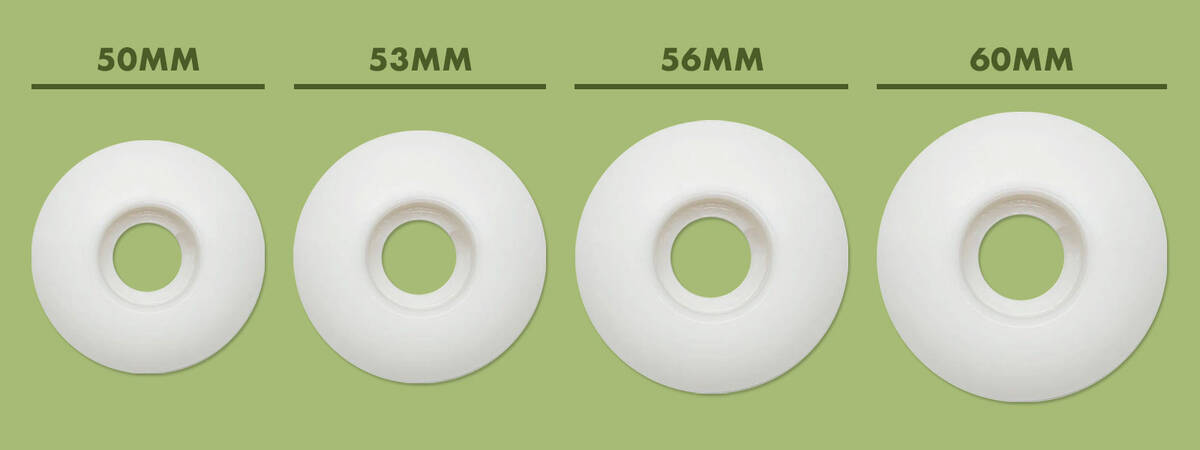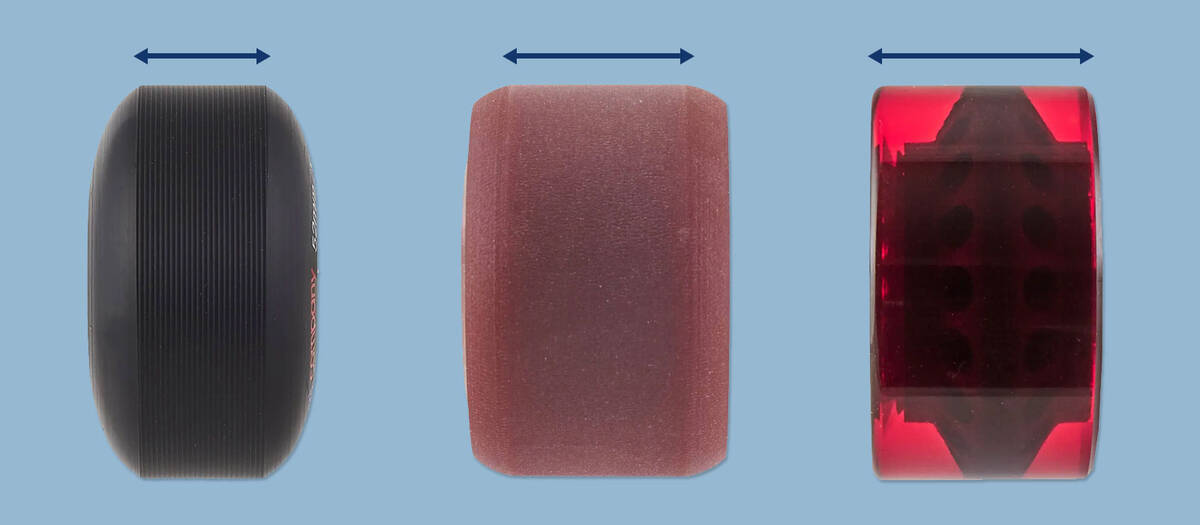Guide for Purchasing Skateboard Wheels
Skateboard wheels hold great importance for your performance – whether you're just starting out or you have advanced skills. These wheels significantly affect how you experience skateboarding, and opting for a different wheel type can completely alter your skateboard configuration. Therefore, it is prudent to contemplate the available choices when picking skateboard wheels.
This guide is designed to offer insights when you're looking for new skateboard wheels. Browse the details below and go directly to a section of particular interest, so we can assist you in selecting the finest wheels for your skateboard.
Overview
Overview
Selecting Skateboard Wheels

When it comes to picking skateboard wheels, focus primarily on two elements: size and hardness. It's essential to select the appropriate wheel size to prevent issues like wheel bites.
Besides size and hardness, consider factors like shape, which impacts the contact patch (the wheel section in contact with the ground), and wheel material, affecting characteristics such as grip, rebound, and weight.
Your personal preferences and riding style will guide you through your decision-making process. Ultimately, the best skateboard wheels are ones that align with your style and preferences, enhancing your enjoyment on the board, regardless if you are new or experienced!
Below you can find more precise and in-depth guidance on finding the right skateboard wheels tailored to your requirements.
Dimensions of Skateboard Wheels

The dimensions of skateboard wheels are assessed by diameter, which heavily impacts speed, acceleration, and manoeuvrability characteristics.
Skaters focused on agility and technical tricks tend to favour smaller wheels, while larger wheels are optimal for cruising or vert skating. Here are the general distinctions between larger and smaller skateboard wheels:
Smaller wheels:
- Agile, manoeuvrable, and ideal for tricks. Although they may not reach the speeds achieved by larger wheels, they are notably more responsive.
- More inclined to sudden stops if faced with a small pebble, resulting in less forgiveness.
- Mellower popping angle enabling ease in executing flip tricks and ollies with reduced effort.
- Low trucks are compatible with smaller wheels, assisting with a lower centre of gravity placement.
Ensuring Bigger Wheels:
- Facilitate higher speeds with slower acceleration and reduced manoeuvrability.
- Offer more forgiveness upon hitting small pebbles or surface irregularities.
- Steeper pop angle provides greater leverage for substantial tricks, although requiring more effort.
- Possibly need higher trucks or riser pads to prevent wheel bites.
The typical range for skateboard wheel sizes is around 52-56 mm. Unless heavily involved in vert skating or cruising primarily, you will likely find wheels meeting your requirements within this range.
Refer to the skateboard wheel size chart below for a concise overview of wheel diameters and the skateboard disciplines usually linked with each size.
| Size | Size in mm | Recommended for |
| Medium sized wheels | 50-53 mm | Street, park |
| Medium sized wheels | 53-56 mm | Street, park, bowl, mini ramp |
| Large skateboard wheels | 56-60 mm | Cruising, vert |
You can refine our skateboard wheel selection by diameter, ensuring you find the precise fit for your requirements:
Understanding Skateboard Wheel Hardness – The Durometer Scale
Skateboard wheel hardness is evaluated with the durometer scale, typically expressed with a number followed by an A. As an example, wheels rated 100A are firmer than those rated 99A. Occasionally, the specifications might feature a B instead of an A, which means a 20-unit deduction on the A-scale. For instance, 83B wheels correspond to 103A.
Below are guiding principles to determine whether to select skateboard wheels either harder or softer than your current ones:
Harder wheels
- Provide higher speed and durability
- Less gripping and shock absorption
- Vibration-prone and noisy on uneven surfaces
- Greatly responsive and quick on smooth terrains
- Ideal for tricks in urban streets or skateparks
Softer wheels
- Offer more grip, traded for speed and longevity
- Dampen vibrations and the roughness of uneven terrains
- Opt for softer wheels when filming skateboarding to reduce discomfort and noise
- Suitable for cruising in various environments
| Hardness | Durometer | Recommended usage |
| Very soft wheels | 78A - 90A | Cruising, filming, commuting, beginners |
| Medium soft wheels | 90A - 97A | Cruising, rough surfaces, commuting, beginners |
| Medium hard wheels | 97A - 99 | Street skating, mini ramps, skateparks |
| Hard wheels | 99A + | Technical skateboarding |
While exploring our offerings, filter by wheel hardness and other crucial attributes to display only the wheels that truly match your needs:
Skateboard Wheel Shape - Contact Patch & Lip Shape

The contact patch is a vital consideration concerning skateboard wheel shapes. 'Contact patch' denotes the part of the wheel that contacts the ground during skating.
Wheels with narrow contact patches tend to exhibit greater responsiveness, reduced friction, and are more prone to sliding (beneficial for blunt slides!). With slimmer wheels, weight is consolidated on a smaller area, making vibrations on rough surfaces more noticeable. Additionally, such wheels are lighter as they consist of less sidewall material.
Conversely, a broader contact patch leads to a grippier and more stable wheel, significantly reducing its slide potential when compared to a narrow contact patch. However, it also means the wheel is less responsive and heavier.
Aside from this, a rounded lip shape makes it easier to manoeuvre over copings and reduces the likelihood of 'hang-ups' when skating transitions.
Wider contact patch:
- Increased grip and stability
- Lower slide propensity
- Decreased responsiveness
- Broader wheels are bulkier
Narrower contact patch:
- Higher responsiveness
- Reduced friction
- More prone to sliding
- Vibrations on rugged surfaces are felt more
- Slimmer wheels are lighter
Composition of Skateboard Wheels
Primarily constructed from polyurethane, manufacturers of skateboard wheels continuously tweak and develop new urethane compounds to yield superior wheels. Adjusting the urethane mix can modify the wheel's hardness, durability, smoothness, bounce, and sliding potential.
Bounce Characteristics of Skateboard Wheels (Properties of Urethane)
Originally crafted from metals or ceramics, skateboard wheels were revolutionised with the advent of urethane wheels. The first urethane wheels introduced a game-changing advantage: bounce. Upon hitting a solid surface, a urethane wheel temporarily deforms, then rapidly returns to its original form, generating bounce. This newfound ability transformed the sport, establishing skateboarding as experienced today.
The quality of skateboard wheels hinges on strict production standards. PU formulas, moulding methods, curing, and baking temperatures lie at the core of skateboard wheel advancements. When selecting skateboard wheels, you'll focus on dimensions, hardness, and shape. Yet, because fine-tuning of PU formulations and production methodologies substantially affects wheel quality, opting for high-grade wheels from reputable brands is always wise.
Prime Skateboard Wheels For Park
For park skating, skateboard wheels should ideally be small to medium-sized (50-56mm) with a hardness rating (durometer) between 99A and 101A, for smooth and responsive performance on sleek surfaces. A rounded shape facilitates versatile manoeuvres for tricks and transitions, while robust polyurethane construction ensures durability and excellent grip on ramps and bowls.
Top Wheels for Street Skateboarding
Street skateboarding wheels are best when small to medium-sized (50-56 mm), with a hardness (durometer) between 97A and 101A, providing superb responsiveness and control over rugged terrain. A broader contact patch enhances stability for tricks like slides and grinds, while a conical or rounded shape ensures rapid acceleration and manoeuvrability. Opt for high-grade polyurethane for lasting durability and reliable traction on concrete and asphalt surfaces.
The suggestions above are for street skateboarding purposes. However, for merely cruising the streets, larger wheels might provide a smoother ride over rougher surfaces. Softer than 97A wheels are recommended (78A - 85A if focused solely on cruising!).
